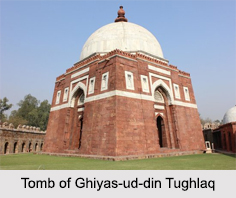 Tomb of Ghiyas-ud-din Tughlaq is a family mausoleum which was made up of stone edifice decorated with marbles. Ghiyas-ud-din Tughlaq was the founder of Tughlaq dynasty of the Delhi Sultanate in India. Located on the southern part of the Tughlaqabad Fort, this structure monument stood at the centre of a large reservoir which used to be filled with water. While the Sultan of Delhi, Ghiyas-ud-din Tughlaq decided to fortify every corner of his territory in order to save it from external attacks, he included his fort as well. This monument which is located across the Bardarpur border reflects one of simplest form of architecture which existed during the period of Delhi Sultanate. Though the reservoir is no more filled with water and the bridge between the tomb and the fort is broken for building highways, yet this monument is regarded as one of the significant historical models of Delhi.
Tomb of Ghiyas-ud-din Tughlaq is a family mausoleum which was made up of stone edifice decorated with marbles. Ghiyas-ud-din Tughlaq was the founder of Tughlaq dynasty of the Delhi Sultanate in India. Located on the southern part of the Tughlaqabad Fort, this structure monument stood at the centre of a large reservoir which used to be filled with water. While the Sultan of Delhi, Ghiyas-ud-din Tughlaq decided to fortify every corner of his territory in order to save it from external attacks, he included his fort as well. This monument which is located across the Bardarpur border reflects one of simplest form of architecture which existed during the period of Delhi Sultanate. Though the reservoir is no more filled with water and the bridge between the tomb and the fort is broken for building highways, yet this monument is regarded as one of the significant historical models of Delhi.
Architecture of Tomb of Ghiyas-ud-din Tughlaq
Tomb of Ghiyas-ud-din Tughlaq is a very simple structure which is mainly designed as a warrior"s tomb. Designed in the Indo-Islamic style of architecture, the tomb of Ghiyas-ud-din Tughlaq follows the trademark style of the buildings belonging to the Tughlaq Dynasty. The tomb was constructed in 1325, made up of sloping red sandstone and white marbles which has arch shaped gateway decorated with beautiful latticework with white marble. The tomb is mainly white in colour decorated with some inscriptions from the Holy Quran including some panels which are decorated as borders on the walls of the tomb. It contains some lattice screens and lotus-bud edge which decorates the monument. There are no minarets surrounding the tomb.
Graves in Tomb of Ghiyas-ud-din Tughlaq
Tomb of Ghiyas-ud-din Tughlaq unlike other tombs is a family tomb which includes the grave of sultan"s wife Makh Dumai Jaan and his second son Mahmud Khan who died with him under the pavilion. Towards the left of the entrance in the corridor there is a tiny grave which is said to be Sultan"s favourite dog which is different from the usual conventions of the Muslim tombs.
Thus the tomb of Ghiyas-ud-din Tughlaq has been one of the significant monuments of Delhi which describes not only the excellent architecture of Tughlaqabad but also Adilabad Forts which carry the origin of Delhi Sultanate.



















